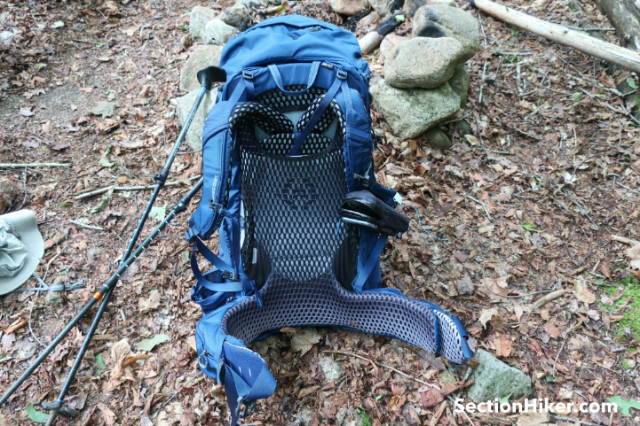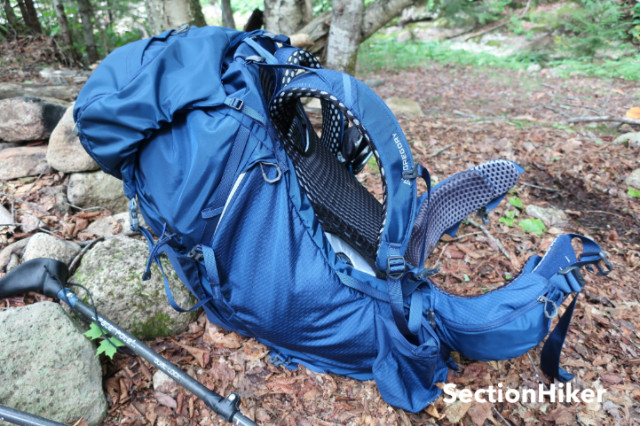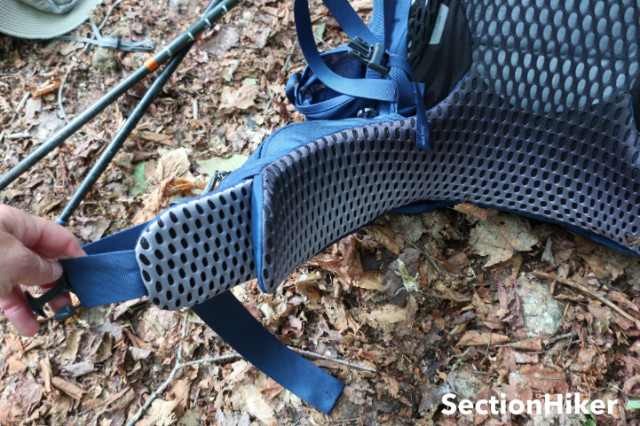The Gregory Katmai 65 is an internal frame backpack with an adjustable torso length, an adjustable-sized hipbelt, and a suspended mesh back panel. The pack is loaded with pockets and has multiple access points that make it easy to organize and access your gear on the go without having to unpack and repack everything. It is quite comfortable to wear, even when fully loaded, and makes a great backpacking and travel backpack for trips where you need to live out of your pack for an extended time.
Specs at a Glance
- Gender: Men’s (the women’s version is called the Kalmai 60)
- Weight: 4 lbs 11 oz
- Frame: Internal frame
- Closed Pockets: 6
- Suspended Mesh Backpanel: Yes
- Adjustable Torso Length: Yes
- Adjustable Hip Belt Length: Yes
- Pack Access: Top / Bottom / Side
- Hydration System Compatible: Yes (not included)
- Raincover: Not Included
- Bear Canister Capable: Vertical
- Materials: 210-denier 40% recycled nylon/420-denier 45% recycled nylon
Backpack Storage and Organization

The 65L Gregory Katmai can hold an enormous amount of gear, far more than you’d expect in a 65L backpack. Gregory doesn’t include the extension collar volume in their pack volume computations, which explains why the pack can swallow so much gear (about 5-7 liters more than spec). In addition to the main compartment, the Katmai also has numerous external pockets for storing gear: 3 pockets in the top lid, 2 pockets on the front of the pack, a side water bottle holster, a side mesh pocket, and 2 hip belt pockets. These pockets make it easy to pack and organize your gear, particularly smaller items that you want frequent and easy access to.
Main compartment
While the Katmai 65 is configured as a top-loading backpack with a floating lid pocket, it has a side zipper that provides access to the main compartment so you can remove gear without having to pop the lid and grope around blindly inside to find it. These extra openings are a real convenience on high-volume packs, so you can access gear without having to unpack it all. I can’t tell you how often I have to do this, even with the roll-top packs I normally use.

There’s also a sleeping bag hatch that opens at the bottom of the pack with an optional fabric “shelf” that you can attach to toggles inside the pack to create a separate sleeping bag compartment. However, I find that you get better space utilization if you disable it and treat the main compartment as one large packing space.
Top lid
The lid has two pockets on top, a small one and a large one, with a third pocket underneath. The small pocket is ideal for holding a GPS, Satellite Messenger, map, or compass, while the second is good for holder extra layers like hats, gloves, and snacks. The third pocket on the underside has a key fob inside and makes a secure place to store valuables that need to be accessed less frequently. The top lid also floats, so it can be used to sandwich gear on top of the pack, like ropes or jackets. You can also loosen the rear straps to move the pocket backward if you feel it rubbing against your hat when hiking.

Front Panel Pockets
The front of the pack has a stretch mesh pocket that’s good for stuffing loose layers and damp items like a rain fly or a water filter. It covers a second zippered compartment that has an internal mesh divider that’s good for storing dirty laundry or items that you want to access more frequently. This is great for travel or multi-day backpacks.
Side pockets
The Katmai does not have symmetric side pockets, although there is a mesh pocket on the left side of the pack large enough to hold a 1L Nalgene bottle. The right-hand side does not have a pocket because that side has a side zipper opening to the main compartment. Instead, it has a mesh water bottle holster sized for a 1 liter Nalgene bottle. It’s actually quite a lot easier to use than a side water mesh pocket especially if you have tight shoulders. If you don’t want to use the holster, it folds away under a protective flap on the side of the pack.
If you prefer carrying more water than those 2 liters, you have to use a hydration reservoir w/hose or pack extra bottles elsewhere on the pack. That’s not great for me personally, since I’m not a big fan of putting a hydration reservoir in my pack (for fear of leaks), but it’s not an issue if that’s your preference anyway.

Hip belt pockets
The hip belt comes with two very large pockets, both faced with sold fabric and reinforced against abrasion. They have beefy zipper pulls that make them very easy to use and are found on all the zippers on the pack.
Compression and External Attachment System
The Katmai comes with two tiers of side compression (webbing) straps that close with side-release buckles. They’re angled though to pull the load closer to your back, making them somewhat less useful for strapping gear, including snowshoes, to the sides of the pack. Webbing loops at the front corners make it easy to attach ice axes or trekking poles in transit, with dual elastic shaft holders, a detail that is left off many backpacks. Sleeping bag straps are also provided but are not removable.

Backpack Frame and Suspension
If the storage and organizational features on the Katmai haven’t wowed you, the backpack frame and suspension system surely will. The Katmai has an adjustable-length torso and ventilated suspension system with an adjustable-length hip belt so you can dial in a custom fit tuned for your body shape. This is a crucial feature for making heavy loads feel lighter weight and easier to carry.
Ventilation
The Katmai 65 has a curved frame with a fairly shallow ventilation cavity to keep the pack close to your body while still providing good airflow to keep you cool and help your shirt dry more quickly when you perspire. The suspended mesh is also treated with Polygiene, which is often used on hunting backpacks, for body odor control. While it helps keep the pack smelling good, the same can’t be said for the backpacker after a few days.
If you carefully at the suspended mesh back panel, you’ll notice that there isn’t a seam between the back and the hipbelt, leading to greater comfort. This is very similar to the Osprey Anti-Gravity mesh panel used on the Osprey Atmos 65, which is very comparable to the Katmai reviewed her.

Adjustable Torso Length and Hip Belt Length
The Katmai 65 is an adjustable torso length pack that makes it easy to increase or shorten the torso length by moving the shoulder straps up or down. The straps connect to the pack body with velcro and are quite intuitive to adjust. The hip belt length is also adjustable. It has extension wings that are also connected by velcro and are used to lengthen or reduce the hip belt length. This is where the rubber hits the road in terms of backpack fit and is a stellar piece of functionality that makes a world of difference in how a pack carries heavy loads.

The top of the shoulder straps and the hip belt both are designed to dynamically pivot as your torso angle changes so the pack moves with you for scrambling or climbing and you don’t have to fight against its inertia. The pivot mechanism also provides an important fit benefit, even when you’re not moving, since the shoulder straps and hip belt will adapt to your body shape and curves. It’s an innovative way to address individual fit differences across a wide range of different body shapes.
What’s the Katmai feel like when it’s fully loaded with gear, food, and water? Surprisingly lightweight. The hip belt and frame are so well padded and do such a great job of transferring the load to your hips while keeping the center of gravity close to your spine/core muscles, that heavy loads really feel lighter. It’s an illusion of course, but one that makes hauling a heavy pack much more natural and comfortable.
Recommendation
The Gregory Katmai 65 is a great multi-day backpack that’s good for longer trips and international travel where you need to carry everything wherever you go. While lightweight packs are all the rage these days, they become increasingly uncomfortable and inefficient to carry when it comes to carrying loads over 30-35 pounds. That’s where having a real frame, an adjustable torso length, an adjustable length hip belt, and a suspended mesh back panel provide a huge increase in comfort and carrying capacity.
Comparison Chart
| Make and Model | Weight | Access | Pockets |
|---|---|---|---|
| Gregory Katmai 65 | 4 lbs 11.8 oz | Top, front, bottom | 7 exterior |
| Gregory Zulu 65 | 3 lbs 11.4 oz | Top, front, bottom | 6 exterior |
| Osprey Atmos AG 65 | 4 lb. 9 oz. | Top | 8 exterior |
| Osprey Rook 65 | 3 lbs 8.5 oz | Top | 5 exterior |
There are a limited number of ventilated backpacks with this volume that have adjustable torso lengths and hip belts, as shown above. The Gregory Katmai 65 is very similar to the Osprey Atmos AG 65 on many dimensions and it’s was clearly designed to go head to head against it in terms of features, weight, and price. Of the two, I think the Katmai 65 makes for a better combination travel and backpacking pack in terms of its organizational layout and features, while the Atmos 65 is more of a pure backpacking pack, with symmetrical water bottle pockets and a removable top lid that is replaceable with a speed lid to reduce gear weight. While the Gregory Zulu 65 and Osprey Rook 65 are lighter weight and less expensive, they’re not as plush as the Katmai 65 or the Atmos 65, but both are still excellent packs and good values.
Gregory Katmai 65 Backpack
Comfort
Weight
Suspension
Features
Adjustability
Sizing
Durability
Disclosure: Gregory provided the author with a sample backpack for an honest review.
Compare 2 Prices
-
 REI
REI$309.95$229.93View -

 Amazon US$309.95View
Amazon US$309.95ViewAmazon.com Price: $309.95 (as of 04/19/2024 09:35 GMT-0400) Details
Product prices and availability are accurate as of the date/time indicated and are subject to change. Any price and availability information displayed on Amazon.com at the time of purchase will apply to the purchase of this product.
 SectionHiker.com Backpacking Gear Reviews and FAQs
SectionHiker.com Backpacking Gear Reviews and FAQs 

Mr Werner,
Thank you. Best review of Katmai 65 that I have read. I have owned Osprey & Gregory; both manufacturers make excellent packs. I tend to prefer Gregory…My neighbor owns Osprey Atmos AG 65 and he prefers Osprey. I bought Gregory Katmai 65… Personal preference. We both agree your review is exceptional.
Take care…I will continue to look for your reviews.
Sean
Thanks for the review. I am looking to upgrade from a Karrimor Jaguar 70-95 (heavy!) which I have been using for several years. Thinking between Katmai 65, Zulu 55/65, Aether 65, Atmos 65. I normally do weekend up to 5 day mountain hikes, mainly summer/fall. Would appreciate your recommendation.
Regards
Scott